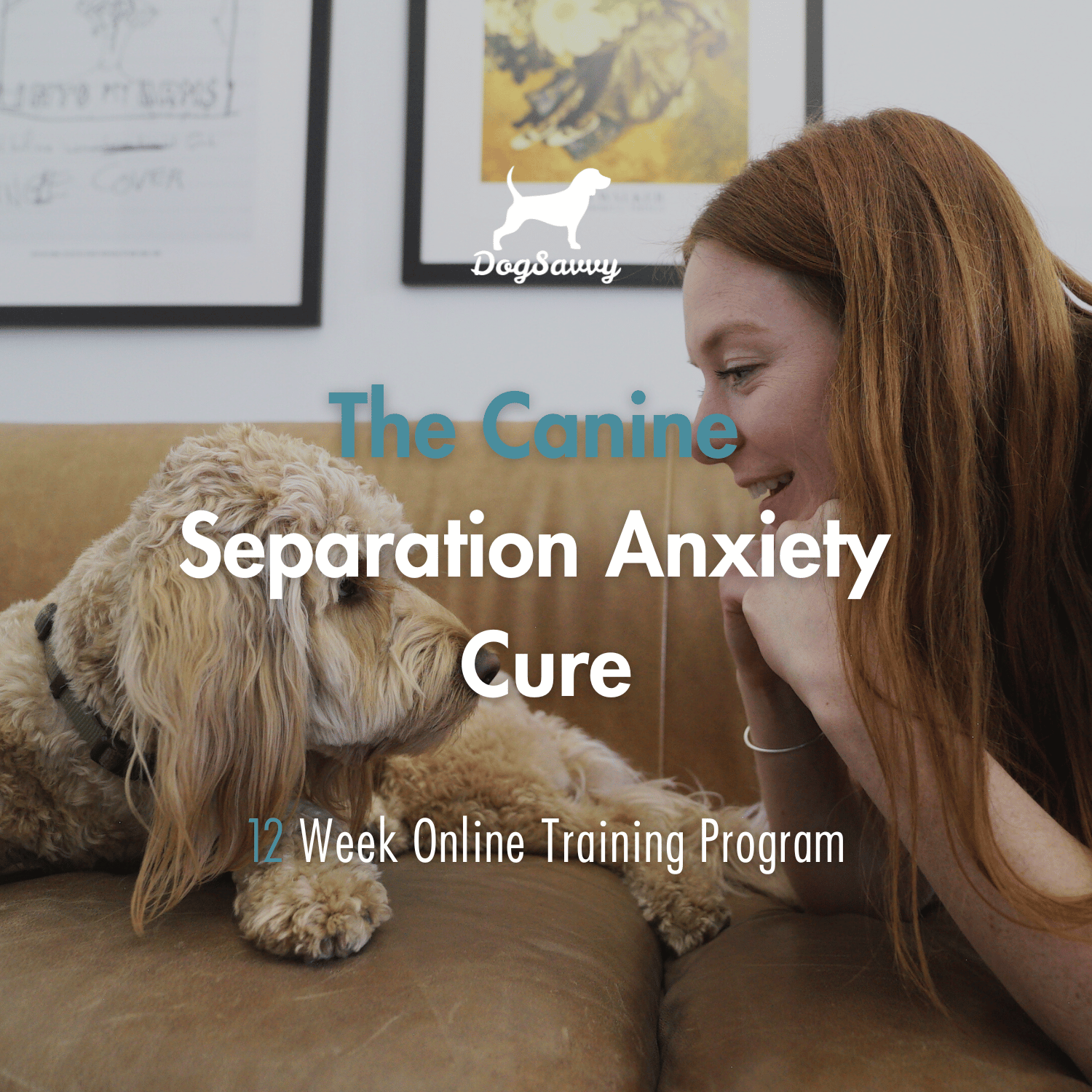Dog Separation Anxiety - Symptoms, Causes, and Treatment
What is Dog Separation Anxiety?
When a dog can’t tolerate being confined, left alone, or separated from its guardian
Dog separation anxiety is a condition that occurs when a dog gets panicked by not being able to see, access, or follow its guardian or any other beloved “pack member” to whom it is attached.
The behavior is most often provoked when a dog is
shut inside a crate, pen, or room;
confronted with barriers like closed doors, gates, and fences;
left at home alone (or in a car or yard alone);
left behind anywhere unfamiliar (like at a daycare and boarding facility).
Symptoms may range in severity from mild (not eating or drinking), to moderate (chronic distress vocalizations and destructiveness), to severe (frantic escape attempts that result in self-harm to a dog and destruction to one’s home), making it difficult - if not impossible - to leave a dog alone.
Generally, if left untreated, the condition will not resolve on its own and worsens over time, making everyday life with a dog feel more like a burden than a source of joy.
Symptoms of Separation Anxiety Can Range from Mild to Severe
Persistent, stress-induced behaviors that occur when a dog is confined or left alone
Symptoms of dog separation anxiety can range from mild to severe and can include any combination of the following chronic, stress-induced behaviors:
Not eating or drinking / mild depression (when a dog lies around and avoids contact with others);
Anxiety before a guardian leaves home or extreme excitement upon their return home;
Loss of bladder and bowel control in an otherwise housetrained dog;
Frantic scratching, digging, and chewing on the sides of a crate, playpen, or kennel (or any barrier such as a closed door, gate, or fence);
Pacing in a fixed pattern, trembling/shaking, or stress panting (when a dog pants heavily despite not having been exercised), often accompanied by whale eye (when a dog’s eyes bulge in its sockets);
Destructive chewing on anything nearby (such as the bedding or pan in a crate, furniture near the exit door, or personal belongings/household items within easy reach);
Persistent distress vocalizations such as non-stop crying, whining, barking, or howling;
Excessive drooling (when a dog becomes soaked in its drool), excessive shedding, and unusually sweaty paws (that leave wet paw prints on the floor);
Extreme escape attempts that may or may not be successful but can result in self-harm (such as broken nails, teeth, and bones), destruction to one’s home (such as when a dog chews on doors and thresholds), or a dog getting lost or killed (because they jump over a fence, out a window, or off a balcony).
Symptoms tend to appear immediately or within the first five minutes
Generally, symptoms will be evident immediately or within the first five minutes of a dog being confined, separated from a loved one, or left alone and will not subside after 30 minutes have elapsed.
Occasionally, some dogs have a delayed reaction to their guardian’s departure (likely because they are not certain if they have left or not), so their symptoms may not appear until after 15 to 20 minutes have passed, but this is much less common.
Unfortunately, once the stress response is activated, a dog’s symptoms tend to persist until it is released from confinement, reunited with its guardian, or has given up from exhaustion.
What Causes Dog Separation Anxiety?
Events that provoke the behavior
Dogs suffering from separation anxiety are most likely to display the behavior in the following situations:
When a rescue dog or puppy gets adopted and is separated from its new guardian for the first time (and every time thereafter)
When a rescue dog or puppy is put in a crate or playpen or left alone for the first time (and every time thereafter)
After a rescue dog or puppy gets used to constant human contact but is suddenly left alone (such as when everyone goes back to work or school after a holiday)
After the sudden loss of a beloved family member or another pet due to breakups, divorce, or death
After a dramatic change in routine or schedule like when a person moves to a new city or spends less time at home because of work
When being dropped off at a daycare, boarding, or grooming facility for the first time
After suffering a traumatic event such as abandonment, change in ownership, or too much time spent in insolation (like dogs who have been chained up their whole lives before being rescued)
The role of pack instincts
Survival instincts are involuntary responses to changes in the environment that all dogs are born with designed to help keep them alive. Pack instincts are one such instinct.
Since survival in the wild for pack animals dictates staying together at all costs, pack instincts compel a dog to keep an eye on their fellow pack members and follow them wherever they go.
This is why our dogs follow us from room to room inside the home and why dogs with this condition feel trapped even when left in the safety of their home.
Ultimately, the condition would be better categorized as a “pack instinct disorder” brought on by a dog’s natural urge to roam with “the pack” being thwarted by the “unnatural” circumstances of being kept as a pet (that can’t go everywhere their human pack members go).
A low tolerance for frustration
A low tolerance for frustration is one of the factors that can contribute to the development of separation anxiety in dogs.
Much like a human being, if a dog has a low tolerance for frustration, it can be easily provoked to act out in undesirable ways that, with regular practice, can quickly become a bad habit.
What this amounts to is poor coping skills on the part of a dog. However, a dog CAN work past its frustrations and learn to relax instead with the right dog separation anxiety training plan.
It’s partly biochemical
When a dog experiences mounting feelings of frustration from being confined or left alone, it can lead to elevated levels of cortisol flooding its bloodstream and the sudden activation of the amygdala, the part of the brain responsible for survival strategies and defense responses.
When facing danger, a dog must act quickly, so sensory information usually decoded by the cerebral cortex (which takes longer to process) gets sent directly from the thalamus to the amygdala, activating a dog’s defense reactions at speed.
This, in turn, can trigger the fight or flight response and the release of adrenaline, which further energizes a dog and escalates its distress, accounting for many dogs’ ability to escape from crates or other enclosed spaces when the behavior is activated.
As a result, much like a human being having a panic attack, your dog’s inability to calm down is partly biochemical.
Past trauma
After experiencing sudden separation from their previous guardian (whether by mistake or design), we speculate that some rescue dogs have “abandonment trauma.”
As a result, they may obsessively follow their new guardians from room to room to keep their eyes on them at all times.
They may also get anxious before their guardian plans to leave home or pack for a trip and resist being “left behind” anywhere unfamiliar like a daycare and boarding facility or the groomer’s and vet’s office.
Dogs with abandonment trauma may not even like being dropped off at a friend or family member’s place if they don’t know them yet.
In some instances, extreme behavior like chewing through doors and jumping off a balcony may be the cumulative result of a dog not receiving crate training as a puppy.
However, it can also mean a dog has spent too much time in isolation or was abandoned in the past - both of which can be psychologically damaging to a dog.
How to Prevent Dog Separation Anxiety
Early crate and pen training for puppies
The best way to prevent dog separation anxiety from developing is to implement crate and playpen training when a new puppy or rescue dog is first brought home so it can get used to not having access to its new guardian all the time.
Downtime in a crate or playpen should coincide with when a pet parent is busy doing other things or plans to be absent from the home so it doesn’t shock the dog when it’s eventually left alone.
However, if you just adopted a rescue dog, it can be more challenging to prevent since their history may be unknown.
A rescue dog may panic the first time it’s left alone in unfamiliar surroundings, so giving it time to settle in and get familiar with household routines before you leave it alone for the first time may do the trick.
But, if a dog was abandoned or left alone frequently in the past, the separation anxiety response may be the result of trauma or an ingrained habit that developed over time. If so, treatment is the only option.
How to Treat Dog Separation Anxiety
Train a dog to self-soothe and relax when confined or left alone
Dog separation anxiety can be treated by systematically conditioning a dog to relax when experiencing confinement and separation from its’ loved ones in brief but tolerable increments.
This can be achieved with a combination of:
Regular crate and pen training that encourages a dog to relax while experiencing confinement or restraint (we call this “Doggy Decompression” training);
Systematic exposure to your departure routine that promotes relaxation when you leave home (we call this “Alone Training”).
When done correctly, a combined application of Doggy Decompression & Alone Training allows the new habit of relaxing to form gradually, without ever placing a dog in a position to feel frustration or distress.
The Canine Separation Anxiety Cure Private Virtual Training Program
Help your dog overcome separation anxiety and regain your freedom in 8 to 12 weeks!
If you’ve tried everything to help your dog, but nothing’s worked, don’t lose hope! With the right dog separation anxiety training program and a little patience, your dog CAN get better.
At Dog Savvy, we provide you with a custom training plan based on your dog’s individual needs, plus one-on-one guidance and support throughout our program until your dog is rehabilitated!
To discuss your dog’s symptoms with a dog separation anxiety specialist and begin training as soon as today, please book an intro session using the link below.
About the Author
Alexandra Bassett is the owner, dog trainer, and behavior consultant at Dog Savvy, a private dog and puppy training company specializing in game-based dog training and solving problem dog behaviors like dog separation anxiety, leash reactivity, excessive barking, and aggression.
She is certified as Knowledge Assessed by the Council of Professional Dog Trainers (CPDT-KA) and is available for online dog training sessions via Zoom. To discuss your puppy’s behavior with Alexandra and receive personalized recommendations, book a consultation using the link below.









